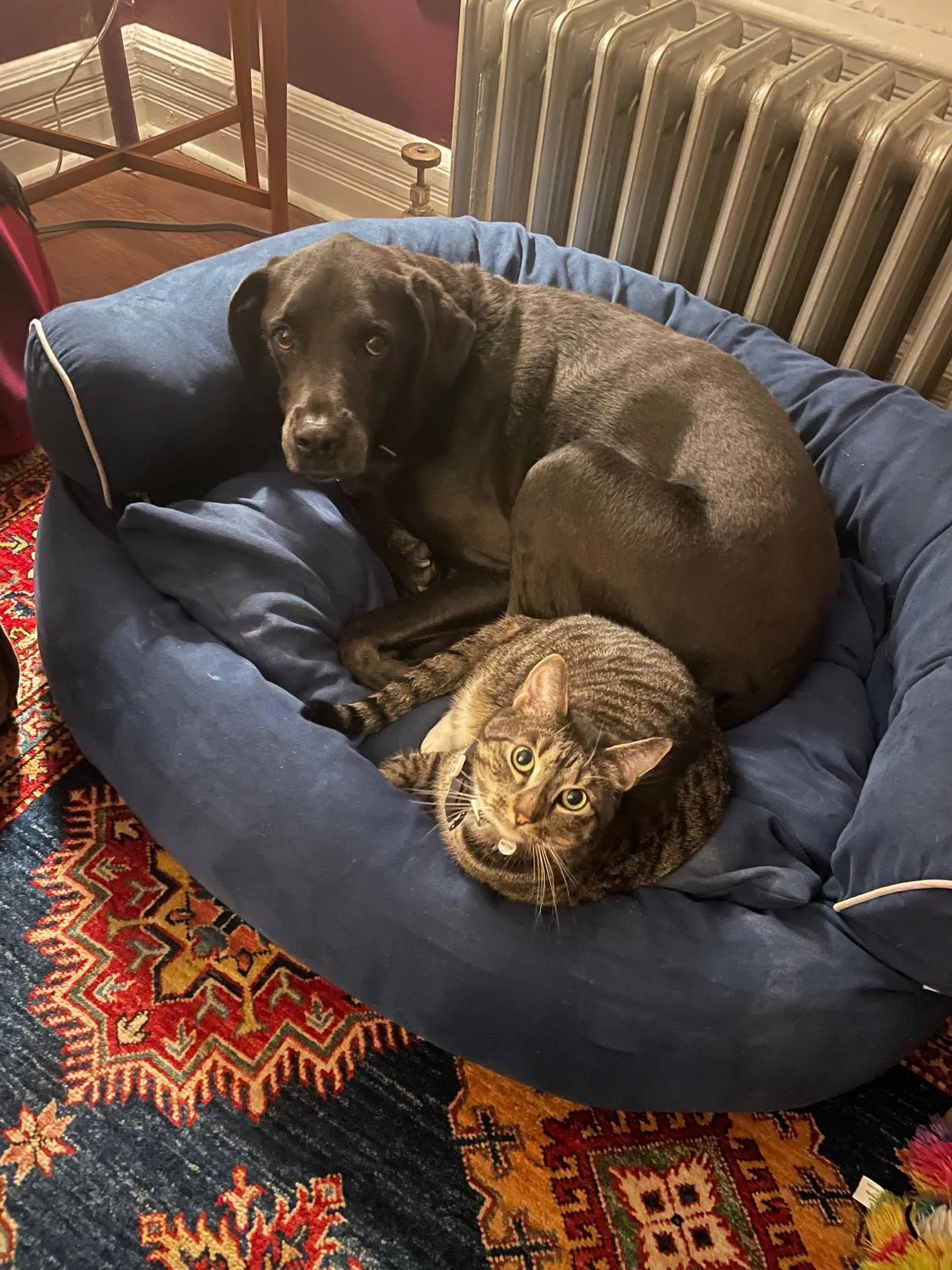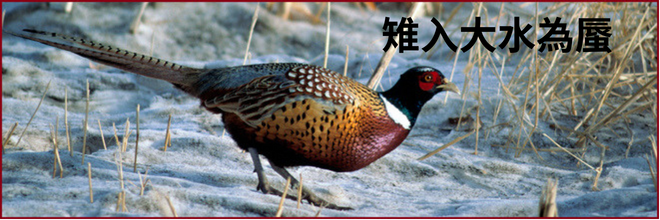It’s been awhile since I’ve had the chance to blog so I’m a little behind on my seasonal posts. I’ve been preparing for a few upcoming classes coming up including one for eLotus that I’m very excited about. In this lecture we’ll be exploring the fundamental mechanisms underlying acupuncture points and point combinations. This is one of my strongest interests – looking for why the points work rather than just memorizing protocols, or treating the points as if they were herbs.
Nelson and Galahad getting cozy in the cooler weather
This time of year is also probably the one where I feel the seasonal shift most. In the northern hemisphere the world is slowing down, darkening, and entering a stage of sleepy hibernation. All I seem to want to do is sleep a little more, walk with Nelson my dog, and practice Taijiquan. I also think more of family, and of the past. The inward turning of the season is something I feel viscerally.
This makes sense to me. Later this week on Wednesday November 8th we enter the Beginning of Winter (立冬) seasonal node. By this date we are only about 6 weeks away from the longest night of the year, the Winter Solstice – also aptly called the Hibernal Solstice. While in the modern American calendar we think of Winter Solstice as the start of Winter, in Asia the seasons are calculated by the balance of Yin and Yang in the natural environment as evidenced by the relative balance of day and night. Since Winter Solstice is the darkest time of year, it is the apex of Yin, and hence mid-winter. Therefore, the early part of November is the beginning of Winter, the time of year moving into the darkest and most Yin. It is interesting to note that in many European traditions, the Winter Solstice was also celebrated as Midwinter.
Chapter 2 of the Huang Di Nei Jing says Winter is the time of “closing and storage” (閉藏). It is the season of hibernation and represents the death phase. However, this should not be construed as a bad thing. We need to enter the phase of ultimate silence and stillness, in other words the death phase, so that Yang (and Yang is life) can be reborn again. The organ associated with the Winter is the Kidney, and the phase is Water. Keeping this in mind will help us understand the basic health recommendations of this seasonal node.
The three Material Manifestations that make up the Beginning of Winter Seasonal Node are Water Begins to Freeze (Shui Shi Bing 水始冰), Earth Begins to Harden (Di Shi Dong 地始凍), and Pheasants Dive into the Watery Abyss to Become Giant Clams (Zhi Ru Da Shui Wei Shen 雉入大水為蜃). All three contain striking Yin images, specifically images of water, of earth, and of moving deep to a hidden and quiet place. The main environmental manifestation of Winter is cold, and East Asian medicine teaches that cold creates hardness and stagnation. Thus, as expressed in these names, both water and the soil of Earth become hard and impenetrable.
The first suggestion for this seasonal node is to nourish and protect the Yang, or warmth of the body (養陽護陽). This is especially true for seniors, since as we age the body become less tolerant of temperature extremes. Be sure to dress appropriately for the cooler temperatures. Likewise, foods should be cooked or warmed when eating. This is not the time for copious amounts of raw vegetables, juices, or chilled foods and beverages. Soups and stews are winter foods! While in some seasons eating too many warming foods can trigger internal heat, this is less so in Winter. Why? For one, Winter is cold. Eating warming foods is necessary to counteract the exterior temperatures as they drop. Second, the natural Qi movement in Winter is inward and downward. As already mentioned, this is the time of “closing and storage.” Eating more warming foods in the Winter allows the body to secure and store that warm vitality, thereby strengthening the body for the seasons to come afterwards. Thus, eating more warming foods in Winter has fewer side effects than doing so in other seasons.
Another recommendation for Beginning of Winter is the consumption of tonics. These are East Asian herbal formulas, often in pill form, that have an overall strengthening effect on the body. The specific tonic should be determined based on individual need, but in general formulas such as Jin Gui Shen Qi Wan can be taken in small but regular doses.
Since Winter is the season of the Kidney, the third recommendation for Beginning of Winter is to safeguard the Kidney and the Jing-essence. According to East Asian medicine there are three things that really deplete the Kidney and the Jing: (1) excessive sex, (2) staying up late and getting too little sleep, and (3) losing one’s temper. Excessive sex is something that varies greatly from person to person. The question to ask patients is does sexual activity leave one feeling refreshed, or tired and worn out. If the latter, then it may be excessive. Staying up late goes directly against the movement of Winter, which is the movement of hibernation; Su Wen chapter 2 tells us that in Winter we need to get to bed a little earlier and sleep a little later, waiting until well after sunrise to get out of bed (早臥晚起,必待日光). Lastly, losing temper or having a generally angry disposition harms the Kidney. In the 39th chapter of the Su Wen it says that anger causes the Qi to rise (怒則氣上). Since the movement of Kidney is a movement of downward storage, anger forcing the Qi to rise depletes Kidney (i.e., it is the opposite movement of Kidney) and impairs the storage of Qi that is the natural and essential movement of Winter.
As more people move indoors this is the time of year for upper respiratory tract infections. Allergies are still plaguing some as well. In East Asian medicine this means that the exterior layers of the body are being challenged. A great basic acupressure to teach patients to help both expel and protect against wind evils is stimulation of Feng Chi GB-20. Massaging this point on a daily basis can help ward off colds and relax stiffness of the next and back that is a main characteristic of Taiyang patterns. If there is concurrent nasal congestion, they can also include acupressure on Ying Xiang LI-20. For this, have them hold Feng Chi on one side of the head while simultaneously pressing into Ying Xiang on the other (for example, their right hand presses right Feng Chi, while the left hand presses left Ying Xiang). Hold until there is a sensation of clearing in the sinuses, and then switch sides. Here’s a video I did of this for my own patients.
Diet for Beginning of Winter
The basic idea for Beginning of Winter diet is to focus on foods that are nourishing and supplementing agents. In general then we want to focus on foods that are warming and nourishing, usually meaning more animal products. We can incorporate foods that are slightly oilier, while still consuming in season fruits and vegetables while they last (we are in the very tail end of apple season here in New Jersey). Foods to incorporate more regularly include lamb, beef, chicken, sparrow, soybeans, sesame, wood ear mushrooms, peanuts, sweet potato, and persimmon (fresh or dried). Warming spices to use include ginger or cinnamon. And patients who are dry or have Yin insufficiency can take either cow or goat milk.
China is a land of multiple culinary traditions and thus seasonal eating recommendations vary from place to place. In the north of China people eat dumplings (jiaozi 餃子), especially those made of lamb and scallion (we’ll discuss a dumpling legend below). In the west of China where it is particularly cold people commonly eat more beef and lamb often in hot pots. In the areas of the high plateaus and mountains the weather is very dry and as such more fruits and vegetables that are still in season are consumed. In the south of China, where it is still relatively more warm even though it is Winter, duck, chicken and various types of fish are traditionally eaten now (i.e., foods that are supplementing but not overly warming).
One simple traditional recipe for Beginning of Winter is Ginseng Congee. To make this simply put 1 cup of rice in with about 8-10 cups water (increase or decrease based on how watery you like your congee), and 9-12g of high quality sliced and dried ginseng root. Bring to a boil and then simmer for at least 40 minutes, or until the rice starts to break up to make a porridge like soup. Another idea that is easy to implement is adding Gou Qi Zi (Goji berries; 枸杞子) to a favorite chicken soup recipe. Doing so focuses the recipe on building the blood, and strengthening the Liver and Kidney.
Zhang Zhong Jing and the legend of dumplings…
Did you know that one of our most famous historical doctors, Zhang Zhong Jing, was not only a master of herbal medicine but also a culinary innovator? According to popular Chinese legend, Zhang was the inventor of the dumpling – jiao zi (餃子). Zhang held a mid-level government position in Changsha. The year he retired from political life he did so around the Beginning of Winter seasonal node. On his travels back to his hometown he came across many people who had suffered frostbite, and as a result had lost parts of their ears. This touched Zhang deeply as he felt sorrow for the suffering of those poor folk.
Once home he found his hometown suffering from an infectious epidemic. The people were starving from lack of food, and also suffering from frostbite. To remedy this he had his assistants set up a large pot on a public square to cook up a remedy. The formula he decided on was a combination of mutton with a number of very warm cold expelling herbs known as Qu Han Jiao Er Tang (去寒嬌耳湯) – Delicate Ears Expelling the Cold Decoction. After cooking the meat was chopped up and wrapped in small wheat flour skins in the shape of ears, and then cooked more and served to the people together with some of the soup. And thus the dumpling was born, as well as the tradition of eating them around the Beginning of Winter!


